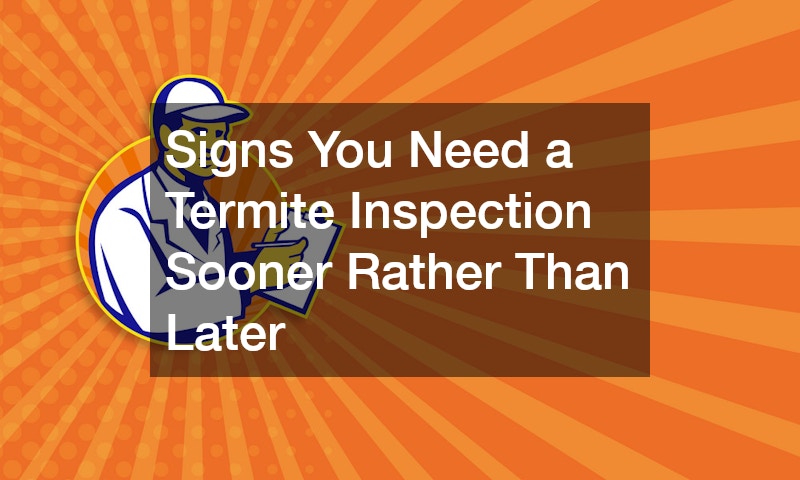Termites can silently cause extensive damage to your home, often going unnoticed until the problem becomes severe. These tiny insects cost Australian homeowners millions in repairs every year. Spotting the early warning signs that indicate the need for professional help is essential to protecting your property and avoiding costly fixes. The longer an infestation goes unchecked, the more difficult and expensive it becomes to control and repair the damage.
Understanding how termites operate and recognising their signs can help you take proactive steps. They usually build their colonies underground or within timber structures, hidden from sight.
This secrecy is why termite damage often goes unnoticed until visible signs appear. Regular checks and knowing what to look for can make all the difference between a minor repair and a major renovation.
Visible Damage & Mud Tubes
One clear sign you need to have your home checked is visible damage to timber or walls. Termites eat wood from the inside out, so damage often starts hidden beneath surfaces. However, as the infestation progresses, you might notice wood that sounds hollow when tapped, blistering paint or sagging floors. These are serious red flags indicating structural weakening.
Mud tubes are another telltale sign. These thin tunnels, built by termites to protect themselves from air exposure, are usually found along foundations, walls or wooden structures. Discovering these tubes around your home’s base or garden should prompt immediate action. They often look like small dirt pathways running vertically or horizontally across surfaces and can sometimes be mistaken for plant roots or debris.
Unexplained Wood Dust or Frass
Termites leave behind piles of fine wood dust or frass as they consume timber. This material often appears near windows, doors or wooden furniture. Unlike regular sawdust from carpentry, termite frass is unevenly scattered and irregular in texture. Finding this dust without an obvious source is a warning that termites may be damaging your property.
If you come across such debris, arrange a professional assessment to confirm the cause. Ignoring the issue allows termites to multiply and spread, increasing potential damage. Early identification of this dust can allow treatment before major repairs are needed.
Buckling Doors & Windows
When doors or windows suddenly become hard to open or close, termite damage may be the culprit. Termites weaken timber frames, causing them to warp or buckle. This can affect your home’s security and comfort. Warping often results in misaligned frames, gaps or increased gaps where drafts or pests can enter.
While other factors can cause warping, combining this with other signs like mud tubes or wood damage strongly suggests a termite problem. Booking a professional check-up will provide clarity and early intervention options. Ignoring such issues may lead to more extensive structural problems over time.
Hollow Sounding Timber & Flooring
Tapping wooden surfaces and listening for a hollow sound is a simple method to detect damage. Termites consume wood internally, so timber may feel soft or hollow even if it looks intact. Flooring, skirting boards and beams are often affected. This hollow sound can sometimes be mistaken for natural wood flaws but usually indicates internal damage.
If hollow sounds accompany other warning signs, call a pest control expert for an evaluation. Early detection means less damage and easier treatment, potentially saving thousands in costly repairs.
Swarmers or Discarded Wings
Termite swarmers are reproductive termites that leave the colony to start new nests. Spotting these flying insects inside your home or near lights is alarming and often indicates an infestation. Swarmers resemble flying ants but have straight antennae and uniform wings.
Discarded wings left on windowsills or floors are another sign termites are active nearby. These wings are often shiny and delicate and can accumulate in noticeable piles. If you see swarmers or their wings, arrange a thorough termite inspection without delay to prevent colony growth.
Increased Pest Activity Around Timber
A sudden rise in pests such as ants near wooden structures can signal termites. Some ants prey on termites, so their increased presence may indicate termite activity. Other wood-boring insects can also coexist with termites, worsening damage.
If you observe unusual insect activity around timber, it’s wise to get your property professionally assessed. Prompt attention can prevent a minor pest problem from becoming a severe infestation.
Previous History Of Termite Issues
If your home has had termite problems or treatments before, remaining vigilant is important. Colonies can return if conditions favour them. Regular professional checks help catch new infestations early and protect your investment.
Ignoring this risk can lead to expensive repairs and disruptions. Staying on top of inspections safeguards your property long-term and ensures you maintain its value.
DIY Inspection Limitations
While you can spot some signs yourself, professional inspectors have specialised equipment to detect hidden termites. Tools like moisture meters, borescopes and infrared cameras help identify infestations behind walls and under floors. Relying only on DIY checks risks missing early warning signs.
Engaging experts ensures an accurate assessment and appropriate treatment plans, providing peace of mind that your home is protected.
Recognising when to get a termite inspection is crucial for protecting your home. Signs such as visible damage, mud tubes, discarded wings and difficult doors all indicate possible termite presence. Acting promptly by contacting pest control professionals can save you money and preserve your property’s structure.
If you notice any of these signs, don’t delay organising a termite inspection. Early intervention means a safer home and peace of mind.





